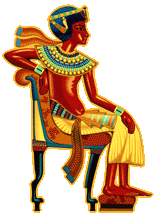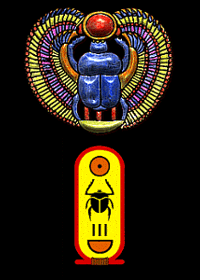| Egyptian Afterlife | Daily Life |
Tutankhamun - Boy King
| Tutankhamun's Burial Mask |
Reigned
1333-1323 BC |
Tutankhamun's Pectoral |
| Tutankhamun's Mummy | Tutankhamun's Tomb |
King Tutankhamun's Burial Mask
|
|
|
|
The gold mask of Tutankhamun, one of the most renowned of all relics of the ancient world, was the gleaming spectacle confronting Howard Carter when in 1925, he opened up the innermost of the three coffins containing the mummified body of the young pharaoh, untouched since the day of his burial 3261 years earlier. The mask of beaten and burnished gold, twenty inches high and weighing twenty-two pounds, covered the entire head and shoulders of the mummy. |
|
DID YOU KNOW: Masks were an important part of the mummification process. They protected the wearer and provided them with a face for the afterlife. Sometimes mummy masks were painted with bright colours or gilded with gold leaf. Mummy masks showed the dead person looking young and healthy so that they would remain young and healthy in the afterlife.
![]()
Tutankhamun's Tomb
| Tutankhamun's tomb is the smallest royal tomb in the Valley of the Kings. The antechamber contained large beds and chariots. The annexe and the treasury were full of smaller, more precious objects. |
|

DID YOU KNOW: Tutankhamun's tomb contained his childhood toys, 116 baskets of fruit, 40 jars of wine and boxes of roast duck, bread and cake. Musicians were buried with their instruments and women with their beauty kits. Eye make-up was included for everyone. Model boats provided transport to the kingdom of Osiris.
![]()
Tutankhamun's Mummy
More than three years elapsed between the discovery of Tutankhamun's tomb in 1922 and the opening of his burial coffins. The innermost one was of solid 22 carat, 110 kilogram solid gold; the two outer coffins, fitted to within half an inch of each other, were of beaten gold on a wood base. Although elaborate precautions were taken to secrete the mummies of all the pharaohs, only the tomb of Tutankhamun escaped the ravages of determined tomb robbers.
The king's body was carefully taken from its wrappings and then photographed. Scientists have not been able to find out what killed the young pharaoh. There is evidence of an injury to the skull that had time to partly heal.
Tutankhamun came to power at age 9 and died at 18 years of age. His 'parents' were originally claimed to be Akhenaten and Queen Nefertiti, however, history records that they only had six daughters. Historians now believe that Akhenaten and his lesser wife, named Kiya, were the true parents of Tutankhamun. Tutankhamun most probably grew up in the palaces of Akhenaten, where he was taught to read and write, which was not very common in those days. The name Tutankhamun is derived from the hieroglyphs, which translate as Tut - ankh - amun, meaning the 'Living Image of Amun'.
Not long after Akhenaten (Tutankhamun's father) died, Tutankhamun became a boy king. He was only 9 years old. At this tender age, Tutankhamun was not responsible enough to make important decisions. Two high officials, called Ay and Horemheb, overtook the decision making on his behalf. Soon after, Tutankhamun married his slightly older half-sister, Ankesenpaaten, one of the daughters of Akhenaten and Nefertiti.
Tutankhamun worshipped the god Amun and returned the treasures taken from Amun's temples by his father, Akhenaten. Akhenaten tried to change the entire religion of Egypt. When he came to power in 1353 BC, the priests of Amun in Thebes controlled much of Egypt's wealth. Tutankhamun stripped the priests of their wealth and power and built a new sacred city dedicated to the god Aten.
![]()
Tutankhamun's Pectoral

A pectoral is a piece of jewellery that hangs over your chest.
The top image is based on a pectoral design discovered in Tutankhamun's tomb. This was discovered in 1922 by Howard Carter in the Valley of the Kings. Its design is inspired by his praenomen hieroglyph (the name he adopted as king), which is illustrated in the cartouche below the pectoral. Tutankhamun, the boy-pharaoh who reigned from the age of 9 until his death at 18, is most famous for his tomb. It was beautifully decorated with wall paintings and contained priceless treasures, the most famous of which was his gold death mask.
| Egyptian Afterlife | Daily Life |